what is trawling and trolling? people get confused about these two fishing techniques. Trawling and trolling both are different fishing techniques. Here we will discuss what is trawling and trolling and how these two techniques are used to catch fish on industrial scale.
Trawling is an industrial fishing technique in which heavy nets are used in the seafloor to catch the fish. These net are towed by one or two boats through water. There are two types of trawling used to catch the fish. One is mid water trawling and the other is bottom water trawling. It is considered as more efficient method to catch large quantity of fish.
Trolling is a fishing practice in which lure are dragged behind fishing vessels at different speed depending upon the habitat, nature and size of fish being caught. It can be done in fresh water as well as in salt water. Trolling is considered as less efficient method as compare to trawling because it require more time and effort to catch fish.
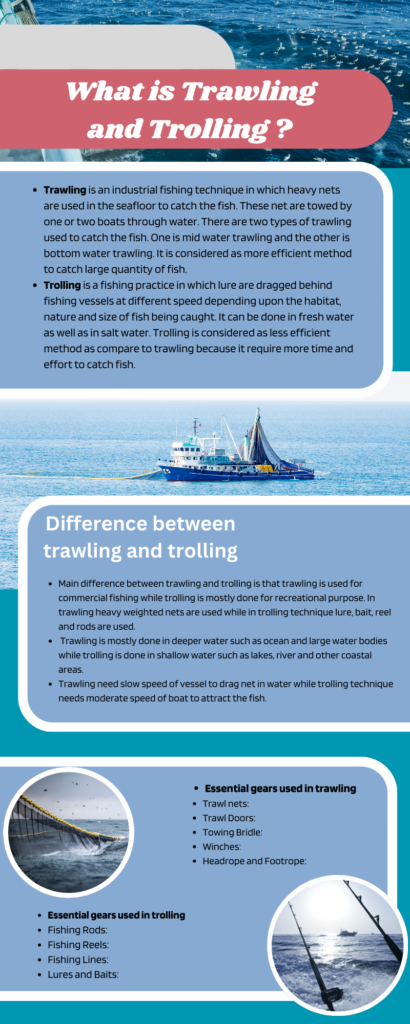
jump to a specific section
What is the main difference between trawling and trolling?
Main difference between trawling and trolling is that trawling is used for commercial fishing while trolling is mostly done for recreational purpose. In trawling heavy weighted nets are used while in trolling technique lure, bait, reel and rods are used.
Trawling is mostly done in deeper water such as ocean and large water bodies while trolling is done in shallow water such as lakes, river and other coastal areas.
Trawling need slow speed of vessel to drag net in water while trolling technique needs moderate speed of boat to attract the fish.
Trawling is used to catch bottom dwelling fish such as cod and shrimp while trolling is used to catch predatory fish such as salmon and trout.
Trawling can disturb seabed and cause pollution in marine ecosystem while trolling have less impact on environment and do not disturb seabed.
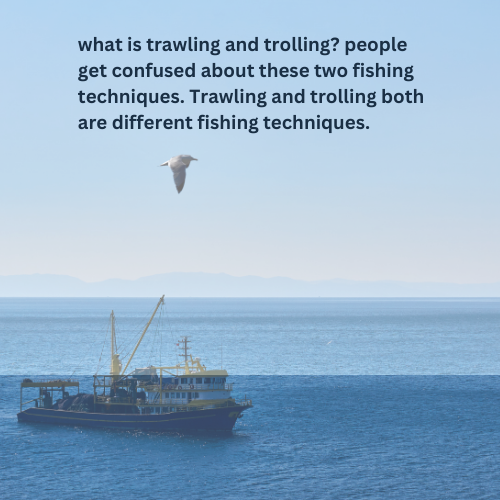
What is Trawling and Trolling All About?
What is trawling?
Trawling is a traditional method of fishing that is used to catch samples of organisms from shallow water to deep sea. Trawl or heavy nets are used to catch fish and cover large areas in deep sea. Different types of trawling operations are used all over the world. Some are originated from other and different modifications occurs in these processes.
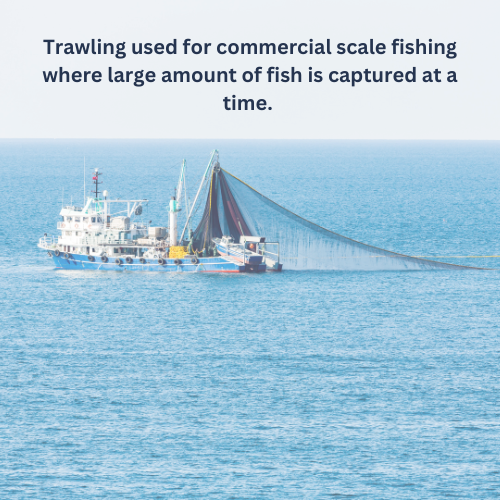
Types of trawling
There are two main types of trawling used to catch fish.
- Mid water trawling
Mid water trawling
Mid water trawling is a fishing practice in which trawl are towed in water column to catch fish. It is used to catch pelagic and non pelagic fish. In some places it is used to catch tuna. Mid water trawling has less impact on sea bed but cause bycatch. Bycatch mean catching unwanted organism along with target species.
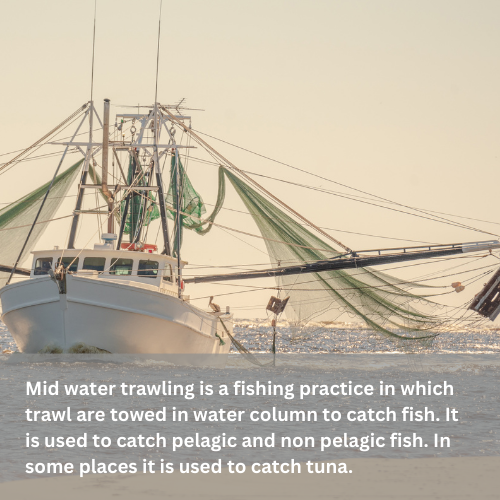
Bottom water trawling
Bottom water trawling is to catch fish from seabed by dragging trawl or nets into water. It is basic commercial fishing technique because it can capture large number of products only in one go. It is used to capture bottom living fish like rockfish, shrimp and squid. Bottom trawling is destroying the natural habitats of marine ecosystem.
Essential gears used in trawling
Essential gears used in trawling are ;
Trawl nets:
Trawl nets are the main gear used in trawling. These are large funnel shaped nets with mesh openings that are especially designed to catch the fish.
Trawl Doors:
These are flat panels attached to the mouth of nets so that it can open horizontally when towed into the water to keep it in desired depth.
Towing Bridle:
These are rope or chain system that are used to connect trawl to towed vessels.
Winches:
These are mechanical devices that are used to adjust the trawl and trawl bridle.
Headrope and Footrope:
These are used to maintain the shape and opening of nets when dragging in water.
Process of trawling
Main step for trawling is to determine the location and check all the trawling gear. Make sure all the equipment are in working condition. Position the trawling vessel at located area and develop trawl net into the water. To trawl net at desire depth fisherman use winches. What is Trawling and Trolling After the adjustment of all equipment start towing the net. Observe the gears continuously during trawling. Speed of trawl should be maintained to minimize the risk of gear damage.
what is trolling?
Trolling is one of the effective methods of fishing. It is a fishing technique in which hooked lure are dragged through water. It is used to catch fish near the surface of water. Multiple motors and outriggers are used to spread the lines widely.
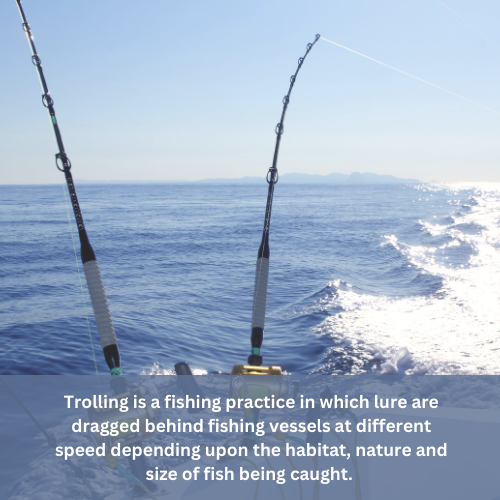
Essential gears used in trolling
Following are essential gears that are used in trolling technique.
Fishing Rods:
A rolling boat can have four to six fishing rods. If you are going to catch big fish you have to use heavier rods.
Fishing Reels:
These are designed to hold heavier fishing line and can also withstand the pressure of large fishing.
Fishing Lines:
These are artificial or natural baited hooks that are trailed by vessels. More than one lines can also be towed at the same time by using outriggers.

Lures and Baits:
Bait are attached to hooks that are used to attract the fish in water. Lure and baits are in the shape of fish prey and are present at the end of fishing line attached to the hooks.
Downriggers:
Downriggers are those devices that are used to control the depth of fishing line.
Process of trolling
First of all select a location for trolling. Than prepare equipment so that all the equipment are in working condition. What is Trawling and Trolling ? Now attach lure and bait to fishing line and adjust the depth of lines you need in water. Speed of vessels should be kept steady so that fish can be attracted easily. We can say that speed of vessels is main factor for successful trolling.
Impact and Consequences of Trawling and Trolling
Trawling, a method of fishing that involves dragging large nets through the ocean, has significant environmental and ecological consequences. One of the primary concerns is overfishing, where trawlers deplete fish populations faster than they can reproduce. This unsustainable practice can lead to the collapse of entire fish species, disrupting marine ecosystems and the livelihoods of communities that depend on fishing.
Another major issue with trawling is bycatch—the unintended capture of non-target species, including dolphins, turtles, and other marine wildlife. Bycatch not only threatens the survival of these species but also disrupts the food chain, impacting the entire ecosystem.
Trawling also causes physical damage to the ocean floor. Bottom trawling, in particular, involves dragging nets along the seabed, which can destroy delicate habitats such as coral reefs and seagrass beds. This destruction can take decades, if not centuries, to repair, leading to long-term damage to marine biodiversity.
Trolling: Psychological and Social Effects
In the digital realm, trolling refers to the act of deliberately provoking or harassing individuals or communities online, often leading to severe psychological and social consequences. Cyberbullying is one of the most harmful effects of trolling. Victims of online trolling can experience anxiety, depression, and in extreme cases, may even be driven to self-harm or suicide. The anonymity of the internet often emboldens trolls, making it difficult to hold them accountable for their actions.
Trolling can also have broader social implications. It can disrupt online communities by creating a toxic environment where meaningful discourse is drowned out by negativity and harassment. This not only silences individuals who might otherwise contribute positively to discussions but also undermines the overall quality of online interactions.
Moreover, trolling can contribute to the spread of misinformation and the polarization of public opinion. Trolls often exploit controversial topics to incite arguments, leading to the entrenchment of extreme views and the breakdown of civil discourse. This can have far-reaching effects on society, as it erodes trust in online platforms and the information shared on them.
Conclusion
Trawling and trolling both are best techniques to catch fish. Trawling is used for industrial scale to provide fish into the market. Trolling is also used for commercial purpose but mostly used in recreational activities.
Trawling can capture large amount of fish at time. What is Trawling and Trolling It is main technique that is used in fishing industry to fulfil the need of seafood. But trawling is also destroying marine life. Seabed habitats are in danger due to it. Nets used in this method are destroying the marine ecosystem.
Trawling net catch all the organism that comes in its way. So it is causing overfishing. If we want to protect marine ecosystem and control overfishing , we have to less the activity of trawling.
Trolling has less impact on marine ecosystem. Bycatch is less in this technique. It can be done on large areas hence chance of successful operation increases.
So we should use both of these techniques keeping in mind that our environment should no be affected by them.